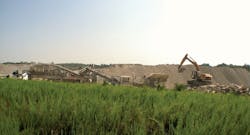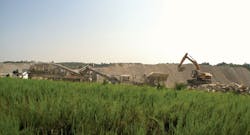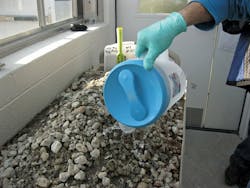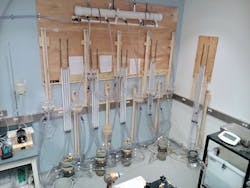A permanent fill-in?
The concept of mechanically stabilized earth (MSE) technology dates back to the earliest of human history when people used sticks and branches to reinforce mud dwellings.
The oldest known MSE-like structure in the U.S. dates back to the 1880s and can be found along the Mississippi River. Modern MSE structures, as we know them now, have been constructed in the U.S. for almost 50 years starting in the 1970s. Today, we have extensive knowledge on how to design and construct them and comprehensive manuals and books outlining the design and construction details. Additionally, the American Association of State Highway & Transportation Officials (AASHTO) has a specific section within its Bridge Design Specifications to address the requirements for designing retaining walls using MSE technology. If properly designed and constructed, MSE technology leads to reliable structures with great load-carrying capacity, tolerance to differential settlement, and, to an extent, resistance against earthquakes.
One of the characteristics of MSE structures is their simplicity in construction. Although expertise is required to construct them, all parts of the structure may be constructed with equipment that is readily available on most earthwork construction sites. Another unique feature of MSE structures is that they are constructed predominantly using backfill, although the backfill has to be properly selected based on certain gradation, plasticity index and soundness requirements, and must be free of organic matter and other deleterious substances. Deviating from these key requirements must be carefully evaluated during design, and unless proper performance can be confirmed should be avoided. On the other hand, certain design requirements may become more important than others, depending on the material available to reinforce the backfill. For example, backfill that may result in a corrosive environment is particularly important for metallic reinforcements, and backfill that may result in high pH is particularly important for certain geosynthetic reinforcements.
In some parts of the U.S., one of the biggest challenges with constructing MSE structures is to find the backfill material that meets all of these requirements. If the owner requires the contractor to meet these requirements and is willing to pay for it, a solution is always available, regardless of what is locally available or not. However, the high cost or the lack of availability of the select backfill may be of occasional issue for selecting to construct MSE walls. In these situations, a potential solution might be an alternative backfill produced from recycled materials as opposed to natural aggregate.
According to the EPA, over 140 million tons of RCA is produced in the U.S. each year. This creates a potential for great economical incentives for both the producers and owners.
Making it attractive
One of the materials of interest is recycled concrete aggregate (RCA) produced from crushed concrete (e.g., curb and gutters, rigid pavement surface, structural concrete from demolished buildings, hardened washout that is left over from recent construction). According to a 2015 Environmental Protection Agency report, over 140 million tons of RCA is produced in the U.S. each year. This creates a potential for great economical incentives for both the producers and owners. By recycling RCA, the producers may save the costs associated with landfilling or storage, and the owners may get a product cheaper than obtaining natural aggregates. Although some owners are still hesitant to use recycled materials, it is a necessity for supporting the sustainable/green infrastructure movement, as recycling these materials saves millions of tons of landfill space. Additionally, we now have the technology to create aggregate from crushed concrete on-site, which would provide additional benefits on transportation costs.
The Sustainable Geotransportation Infrastructure (SGI) Research Group (http://geotrans.vse.gmu.edu/home) at George Mason University (GMU) as well as other universities such as (but not limited to) the University of Wisconsin, Madison (UW), and the Recycled Materials Resource Center (RMRC) and the University of Maryland, College Park (UMD), have been evaluating the use of RCA in geo-infrastructures for several years. Here are a few properties and strengths researchers have been investigating:
• RCA has the appropriate index and engineering properties to be considered a suitable backfill for MSE. Overall the classification of RCA (in accordance with Unified Soil Classification System [USCS]) ranges from well to poorly graded gravel (GP or GW) to sand (SP or SW) to well graded silty sand (SM-SW). The fines content (passing the No. 200 sieve) of RCA, based on published values, ranges from 3% to 12% and in all cases RCA is characterized as non-plastic. Also similar to natural aggregates with fines, RCA is sensitive to water content changes during compaction and results in bell-shaped water content dry-density curves regardless of the compaction method used (vibratory, modified or standard Proctor). RCA particles are strong enough that they do not break during compaction, and RCA also has reasonable abrasion resistance as defined by micro-deval tests. The published specific gravity of the RCA ranges from 2.2 to 2.7, which varies due to the amount of mortar and the parent rock used in production of the concrete;
• Due to its high water absorption capacity, in general the optimum moisture content of RCA is higher than that of natural aggregates. It is not uncommon to have optimum moisture content at around 12% to 15%;
• Research suggests that in some cases RCA exhibits similar to better resistance to freeze-thaw cycles than natural aggregate with similar gradation; and
• In general RCA produces reasonable interface friction and pullout resistance to reinforcements used in MSE structures.
All of these properties make the RCA an attractive material to be considered for MSE structures. However, RCA is a complex material because it is created from concrete used in a variety of applications. Therefore, the properties of the RCA to be used for a specific project must be verified as opposed to relying on previously published values.
The Federal Highway Administration’s (FHWA) Geotechnical Engineering Circular (GEC) No. 11 points out two concerns with RCA:
• The potential to produce tufa precipitate from unhydrated cement; and
• The potential to have electrochemical properties that are outside of what is considered acceptable by AASHTO Design Specifications.
The first concern is associated with potentially clogging the drainage systems of the MSE structure, and the second is associated with potentially corroding the metallic reinforcements. Although evidence exists about tufa precipitate and high values for electrochemical properties, currently there is not enough data to confirm the potential adverse effects. Therefore, at this stage, both of these concerns are legitimate but not proven facts.
To understand the complexities of RCA, GMU’s SGI research group has been investigating the chemistry of RCA, the carbonation and aging process, drainage properties, the tufa build up and precipitation of mineral crystals as well as mixing RCA with virgin aggregate. While the research is ongoing, some of the results are already published. The research involved three stages.
The research involves monitoring two piles: one that is placed on the GMU campus and the other placed in the Greenhouse Laboratory, where the temperature and humidity are controlled.
In stage 1, GMU’s team collected RCA from a producer within weeks of production (after the concrete from all sources was mixed, deleterious material was segregated, concrete was crushed and screened to particle size 100% passing a 1-in. opening). The collected material was then used to create two different RCA piles: one that is placed on the GMU campus (outside) and the other placed in the Greenhouse Laboratory, where the temperature and humidity are controlled. Both of these piles underwent wet and dry cycles but the samples in the laboratory were aged with synthetic rainwater and the one outside was left at the mercy of the weather. These experiments provided six important results:
• Chemistry of the RCA changes over time (based on major, minor and trace element analyses) and the changes occur more rapidly within the first couple of months than later on;
• Water leach tests provide means to trace activity of the RCA, which may come in handy if the stockpile of RCA was needed to be evaluated to understand the chemical stage at which the RCA stockpile is at before using RCA in any geo-structure;
• Carbonate content of RCA increases with time and the pH decreases with time;
• Total release concentrations of several elements including alkali metals (e.g., calcium, magnesium) decreases with time due to the aging process and carbonation. In terms of equilibrium chemistry, this may mean reduction in the potential for tufa precipitation;
• Observed behaviors in the laboratory and field match well, although the increase in carbonate content occurs faster with more frequent wetting and drying; and
• Based on equilibrium chemistry, blending as high as 40% freshly produced RCA with virgin aggregate significantly reduces the potential of tufa precipitation compared to 100% RCA. However, because with time the potential to precipitate tufa from RCA reduces (due to aging and carbonation), the effect of further reducing the potential of tufa precipitation is not as pronounced when virgin aggregate is mixed with aged RCA.
In stage 2, samples obtained from laboratory-aged RCA were tested in gradient ratio chambers with geotextile (herein referred to as hydraulic tests). This stage is performed to understand the effects of aging onto hydraulic properties and migration of particles from RCA. Two different geotextiles were used for these tests: a nonwoven and a woven geotextile. Both of these materials are considered to provide worst-case scenarios in terms of clogging. Nonwoven geotextile is typically used to encapsulate drainage systems to create a separation and filtration layer between the backfill and drainage aggregate. If the water is able to pass through this material, then potentially any issues within the pipes of the drainage layer may be dealt with through regular maintenance as the pipes are much more accessible than the geotextile itself. Woven geotextile, compared to all other reinforcement options that may be used in MSE structures, has the highest potential to clog, as most other reinforcement types (e.g., geogrids, welded wire mesh and strip reinforcements) have higher openings for the water to drain.
The RCA samples used in these hydraulic tests were obtained after four, nine and 12 months of aging and each test was conducted for about two months under hydraulic gradients of 1, 2.5 and 5. The hydraulic tests with nonwoven geotextiles were performed by the GMU’s SGI team and the tests with woven geotextile were conducted by the UMD team under the supervision of Dr. Ahmet Aydilek with the same RCA provided to UMD by the GMU team. At the end of each of these tests, the geotextiles were exhumed. Select samples were evaluated in a gradient ratio chamber for changes in permittivity, and the others were evaluated to determine the changes in pore size distribution through an image analyses method developed by Dr. Aydilek. These experiments provided the following important results:
• Tests with nonwoven geotextile showed a reduction of 30% to 60% in permittivity and about 10% to 40% in pore size distribution;
• Tests with woven geotextile showed a reduction of 20% to 40% in permittivity and about 20% to 30% in pore size distribution;
• In most cases the flow characteristics of RCA/geotextile systems were not significantly different than the hydraulic conductivity of the RCA without a geotextile. This is because the permeability of the virgin geotextile is so much higher than the permeability of the RCA. That is why it is not surprising that up to a 50% to 90% reduction in geotextile permittivity is acceptable in practice. Therefore, the permittivity drops observed in these tests also should be acceptable in filtration applications, as the geotextile still has similar hydraulic conductivity than that of sand;
• Aging of RCA did not change the hydraulic conductivity of the RCA. In other words, all aged RCA samples for the purposes of saturated flow characteristics had similar properties and the system was not considered to be clogged;
• In all geotextiles exhumed after the hydraulic tests, the geotextile had white amorphous particles. These results indicate that RCA particles migrate onto geotextile but not at a rate that physically clogs the geotextile. Also the activity measurements (pH, electrical conductivity, total dissolved carbon amount, etc.) between the inflow and outflow chambers during the hydraulic tests showed that when compared to what was observed during aging, RCA is not as chemically active under fully saturated flow. This means that in saturated flow, the conditions do not create a strong environment to result in chemical activity, hence chemical clogging; and
• Different blends of RCA (up to 40%) and virgin aggregate showed hydraulic characteristics (including flow rate, permeability values and observed reduction in geotextile permittivity) comparable to 100% virgin aggregate samples.
In stage 3, to investigate the chemical activity, the GMU team has created new experiments where unsaturated RCA is wetted and dried with synthetic rain. The experiments were created in a setup where percolating water goes through a column of RCA and nonwoven geotextile and then discharges into an area underneath the bottom of the geotextile, which is exposed to atmospheric conditions. These tests are ongoing and the results will be gathered in a journal article very soon and submitted for peer review. Similar to stages 1 and 2, mixtures of RCA (up to 40%) also are blended with virgin aggregate. The preliminary results from these mixtures show acceptable filtration performance. However, initial results indicate that there is certainly some growth of tufa (amorphous particles) on top of the geotextile and also growth of calcite-based minerals with crystalline shape underneath the geotextile. The effects of these growths on the reduction of permittivity and pore size distribution are still being investigated.
Based on this research it can be stated that the precipitation of tufa from RCA is certainly a reality but the initial results certainly do not show a clogged system due to tufa build-up under saturated conditions. This is a very promising and exciting finding but it requires further laboratory and carefully designed field testing (e.g., partially and fully saturated flow conditions) before reaching an ultimate conclusion.
In stage 2, samples obtained from laboratory-aged RCA were tested in gradient ratio chambers with geotextile. Two geotextiles were used: nonwoven and woven.
More to be done
The research conducted at GMU did not particularly focus on addressing the second potential issue in FHWA’s GEC 11 related to electrochemical properties. This is because currently there is an ongoing NCHRP study (NCHRP 21-11) under the supervision of Dr. Kenneth Fishman from McMahon and Mann Consulting Engineers, where the researchers are currently investigating developing new or improved laboratory and field test methods to evaluate electrochemical properties. The outcome of this research is very important because at this stage even though we know that RCA does not always meet the AASHTO requirements for electrochemical properties, what that means in terms of corrosion of metallic reinforcements is unknown. More research is certainly needed to address this issue but first we must have reliable methods to test electrochemical properties and then have target thresholds that define acceptable properties. In the near future, GMU’s SGI team will be looking into ways to collaborate with Dr. Fishman to expand the RCA research to also address this issue.
The research suggests that the use of RCA in construction is promising for economical and sustainable solutions, and as with all new material we must take baby steps—but we must move forward. The following steps are recommended at this stage for MSE wall applications:
• RCA can be mixed with virgin aggregate as opposed to being used by itself. Even mixing 20% to 40% RCA with virgin aggregate creates a pathway to move forward;
• It is not advised that RCA/virgin aggregate mixtures be used in high visibility or critical infrastructure without proven field trials that are well designed and implemented;
• Some tufa build-up should be anticipated and the MSE structure should be designed to compensate for this (e.g., drainage systems should have proper filtration systems and clean-outs and regular maintenance should be included in the overall cost); and
• There is previous information in the literature on using RCA in road base course applications and some cases show success and some do not, but the details of these case studies are lacking. These stories create more questions than answers as the devil is in the details. It is very important that the research community pushes forward exploring the use of RCA, but also it must share the details and results of field trials (or large scale laboratory experimentation). More data is definitely great as long as the details of how the data was obtained and the information is clearly shared through journal articles or technical presentations.




